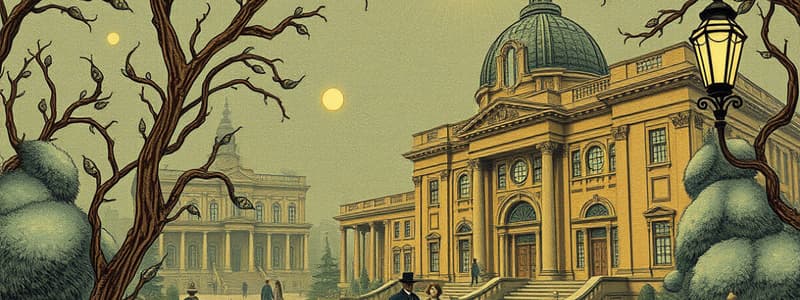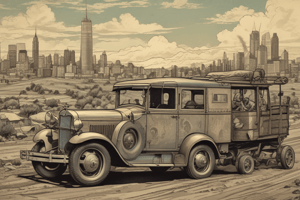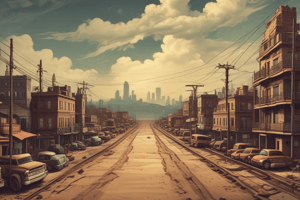Podcast
Questions and Answers
What was one of the key components of President Franklin D. Roosevelt's New Deal?
What was one of the key components of President Franklin D. Roosevelt's New Deal?
- Promising tax cuts for the wealthy
- Creating Social Security for the elderly (correct)
- Deregulating the banking system
- Eliminating government spending
What event marked the end of the economic boom in the 1920s?
What event marked the end of the economic boom in the 1920s?
- The stock market collapse in 1929 (correct)
- The signing of the New Deal
- The establishment of Social Security
- The onset of World War II
How did the government respond to the economic challenges during the Great Depression?
How did the government respond to the economic challenges during the Great Depression?
- By reducing federal regulations
- By providing aid to the unemployed (correct)
- By lowering wages across all industries
- By increasing tariffs on imports
Which initiative was part of the New Deal aimed at economic recovery?
Which initiative was part of the New Deal aimed at economic recovery?
What was a major long-term impact of the New Deal according to historians?
What was a major long-term impact of the New Deal according to historians?
Flashcards are hidden until you start studying
Study Notes
Economic Boom and Collapse
- The 1920s in the U.S. marked a significant economic boom characterized by rapid stock market growth.
- Many investors engaged in speculative stock purchases, anticipating ongoing economic expansion.
- The optimism ended in 1929 with a stock market collapse driven by panic, leading to widespread economic damage.
The Great Depression
- The stock market crash severely impacted the U.S. economy, causing a spike in unemployment and reduced industrial production.
- The period following the crash is known as the Great Depression, a time of severe economic hardship.
Franklin D. Roosevelt’s New Deal
- In 1932, Franklin D. Roosevelt was elected and introduced the New Deal to combat the Great Depression.
- The New Deal consisted of a series of programs aiming to provide immediate relief, economic recovery, and systemic reform.
Relief Programs
- The New Deal's relief initiatives included unemployment aid and the establishment of Social Security for the elderly.
- Significant employment programs were created, including the Public Works Administration and the Works Progress Administration, which constructed infrastructure like roads, bridges, and schools.
Economic Recovery Efforts
- The government initiated the Blue Eagle campaign, led by the National Recovery Administration, to promote fair labor practices and price increases.
- This campaign encouraged employers to treat workers more equitably to stimulate economic recovery.
Economic Reforms
- To stabilize the financial system, the government insured bank deposits, providing confidence to depositors.
- The U.S. Securities and Exchange Commission was established to regulate the stock market and prevent future collapses.
Legacy of the New Deal
- Historians and economists largely agree that the New Deal aided the U.S. economy during the Great Depression.
- Full economic recovery and a significant drop in unemployment were eventually achieved, largely due to increased production during World War II.
Studying That Suits You
Use AI to generate personalized quizzes and flashcards to suit your learning preferences.




